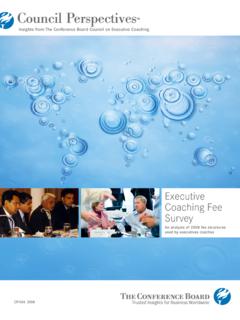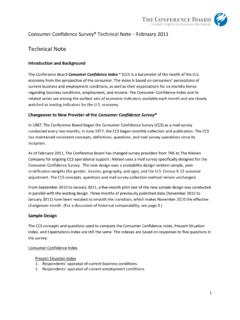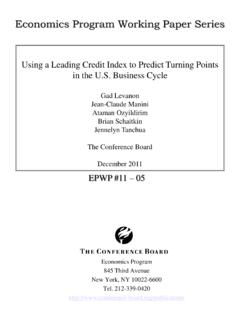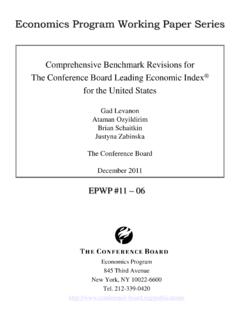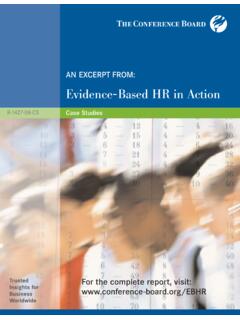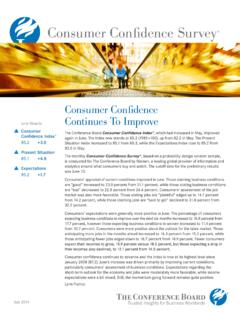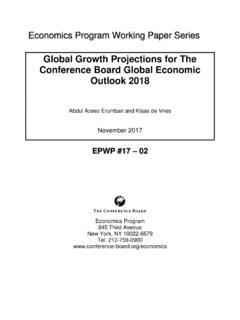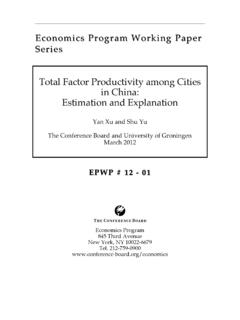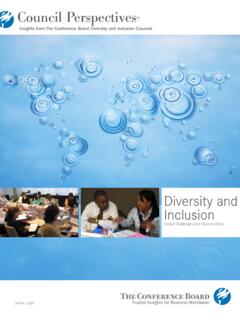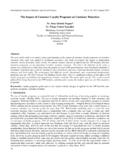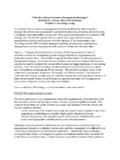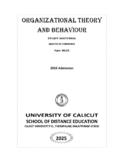Transcription of Creating a Competency Model for Diversity and …
1 Council PerspectivesInsights from The Conference Board Council on Workforce DiversityTMCouncil PerspectivesCreating a CompetencyModel for Diversity andInclusion PractitionersTMCP-005 2008 Council PerspectivesTMMembers of The Conference Board Councils are among the most experienced and savvy executives in the private deliberations produce rich insights on themost challenging business and societal issues of our their permission, we have channeled their energy andexpertise into a platform to voice their views that platformis Council Perspectivesis based on sessions from selectedCouncil meetings, post-meeting interviews, and other pertinent data, and may sometimes include original contentwritten by Council members.
2 It is not intended to be aresearch report; rather, Council Perspectivesprovides aunique look into the minds of executives from leadingglobal organizations as they assess, analyze, and developways to address critical a Competency Model forDiversity and InclusionPractitionersBy Indra LahiriContents4 Executive Summary6 Diversity and inclusion practitioner Competencies 8 The Need for a New Set of Competencies10 Global Diversity and inclusion Competency Model11 Change Management12 Diversity , inclusion , and Global Perspective14 Business Acumen15 Strategic External Relations16 Integrity17 Visionary & Strategic Leadership18HR Competencies 19 Proficiency Levels22 Metrics22 Conclusion23 Survey24 Acknowledgments25 About this Report25 About the Author26A Note of ThanksTen years ago, the word inclusion was rarely used, andonly by a few organizations.
3 Now, the phrase diversityand inclusion has its own acronym D&I. Focus hasprogressed from valuing differences, which was largelyachieved through awareness training and multi-culturalcelebrations, to strategic global business today is on cornering new markets, buildingeffective and efficient global teams, and managing brandreputation. Clearly, the 21st century D&I practitioner ,embracing this more public, decidedly strategic role,requires a challenging new set of are five primary trends driving changes in the D&Ipractitioner s role and that define the need for new think-ing regarding competencies. These are: Globalization Demographic shifts Technology Legal environment Socio-political climateIn order to hire and manage D&I executives, to say noth-ing of completing succession plans that ensure the func-tion s long-term viability, a set of globally applicable,measurable competencies for D&I practitioners at multi-ple levels is Competency Model contained in this report is theresult of an intensive, two-day working session of TheConference Board s Council on Workforce Diversity ,with representatives from the Diversity & InclusionCouncil and the Diversity Business Council.
4 In prepara-tion for this session, members of all DiversityCouncils were invited to share their perspectives via abrief survey. Seventy-six individual respondents sharedtheir thinking on competencies required of a D&I practi-tioner today. Forty-four of these, or 77 percent, work fororganizations with global operations. (A copy of the sur-vey can be found on page 23.) During the working ses-sion, council members used results from this surveyas a springboard, shaping the Model through rigorous dis-cussions. Members of the European, Asian, and CanadianCouncils and the staff who support them provided feed-back and perspective on drafts of the Model and thisreport. The Model was then shared with colleagues fromacross the globe, who provided feedback on its relevanceand Model includes 1) categories of like competencies, 2)the competencies themselves, and 3) behaviorally-baseddefinitions for each Competency .
5 The seven categoriesand their related competencies are:1. Change Management Organizational Development Corporate Communication Critical , inclusion , and Global Perspective Cultural Competence Negotiation and Facilitation Continuous Learning Complex Group Dynamics Judgment Subject Matter ExpertiseExecutive Summary4 Council Perspectives - Creating a Competency Model for Diversity and inclusion Acumen External Market Knowledge Holistic Business Knowledge Diversity and inclusion ROI (Return on Investment) External Relations Corporate Social Responsibility / Government / Regulatory Strategic Alliances Diverse Markets / Supplier Diversity Brand / Reputation Ethics Resilience Influence Empathy & Strategic Leadership Diversity & inclusion Future State Pragmatism Political Savoir-Faire (At HQ and Local Levels) Disciplines Total Rewards / Talent Management / Organizational Development / Work and Life Balance / Training Compliance Employee RelationsTo be used effectively, these competencies should be inte-grated into a company s business metrics.
6 Organizationswould do best to customize simple, clear measures that arepart of an organization s overall metrics for each of theglobal Diversity competencies, or even for each defining these measures is beyond the scope of thisreport, organizations should be asking the question: howcan this person use this Competency to strengthen the busi-ness? Or, what does this person need to achieve to furtherour organizational goals? By attaching simple, business-based metrics to each com-petency, or even to each Competency category, organiza-tions lay the foundation for D&I practitioners to achievesuccess, thereby best supporting organizational Perspectives - Creating a Competency Model for Diversity and inclusion Practitioners56 Council Perspectives - Creating a Competency Model for Diversity and inclusion ManagementOrganizational Development Understands and facilitates thechange process through completion Gains leadership involvement andline ownershipCorporate Communication.
7 Communicates the full spectrum of inclusion Utilizes multiple communicationvehicles such as web sites,brochures, talking points, and more Maintains a balanced global per-spective that offers flexibility andvariations for use at the local level Keeps what is best for the businessat the forefront Elaborates on benefits of D&I Acknowledges and addresses possi-ble unfavorable impact Tracks and communicates strategyprogress and setbacks Acknowledges and addresses chal-lenges / obstacles / opportunitiesCritical Interventions Offers useful and timely interven-tions in cases where progress isimpeded due to a Diversity -relatedissue Diversity , inclusion , and Global PerspectiveCultural Competence Understands multiple cultural frameworks, values, and norms Demonstrates an ability to flex style when faced with myriaddimensions of culture in order to be effective across culturalcontexts Understands the dynamics of cross-cultural and inclusion -related conflicts, tensions, misunderstandings, or opportunities Understands the history, context, geography, religions, and lan-guages of the regions in which the organization does business Is fluent in more than one, and ideally several, languagesNegotiation and Facilitation Negotiates and facilitates through cultural differences, conflicts,tensions.
8 Or misunderstandingsContinuous Learning Recognizes and addresses one s filters, privileges, biases, andcultural preferences Commits to continuous learning / improvement in Diversity , inclusion , and cultural competence Seeks and utilizes feedback from diverse sourcesComplex Group Dynamics Understands and effectively manages complex group dynamicsand ambiguityJudgment Is able to discern when to inquire, advocate, drive, or resolvemore decisivelySubject Matter Expertise Knows and applies best practices in Diversity and inclusion practices, strategies, systems, policies, etc. Understands subtle and complex Diversity and inclusion issuesas they relate specifically to marginalized groups (while thesevary by region, they often include women, people with disabili-ties, older people, and racial, ethnic or religious minorities)
9 Establishes and manages D&I councils effectively Collaborates with other functional teams Is a role Model for inclusive and culturally competent behaviorBusiness AcumenExternal Market Knowledge Understands and is current onglobal and local trends/ changesand how they inform and influence D&I Gathers and uses competitive intelligence Understands diverse cus-tomer/client needs Understands and is current with global socio-political environments Understands context and lessons learnedHolistic Business Knowledge Understands the impact of the financial, economic, and market drivers on bottom line results Understands core business strategies Possesses solid financial acumen Uses information from multiple disciplines and sources to offer integrated ideas and solutions onissues important to the organizationDiversity and inclusion ROI (Return on Investment)
10 Determines and communicates howD&I contributes to core businessstrategy and results Creates insights on how D&I con-tributes both to people and HRstrategies as well as businessresults Designs and develops D&I metricsthat exhibit the ROI impactDiversity and inclusion practitioner Perspectives - Creating a Competency Model for Diversity and inclusion Practitioners7 Strategic External RelationsCorporate Social Responsibility/Government/Regulatory Well-informed about external pressure points ( , society, workcouncils, environment, regulatory,government, customers, and related trends) Effectively anticipates and managesstakeholders ( , advocacy, com-munity, non-government organiza-tions) Recognizes and addresses humanrights issues through policy andpractice Influences media and marketplacevia communication and communityoutreach to competitively positionthe organizationStrategic Alliances Identifies, partners, and leveragesrelationships with key externalorganizations / leaders to enhancebusiness results Diverse Markets/Supplier Diversity Identifies, partners, and leveragesrelationships with key externaldiverse suppliers, organizations, and customers to.

